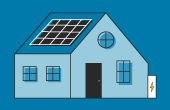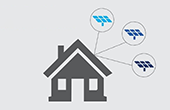Unique KSD "Solar Saver" Dry Air Closed Loop HW System Rises at Synagogue in Warwick
25% to 49%
of hot water
Property
- Owner:
- Temple Am-David
- Type:
- Other
- Address:
- 40 Gardiner St., Warwick, RI 02888
- Energy need met:
- 25% to 49% of hot water
- Event Participation:
- NESEA Green Buildings Open House 2012 Host
- NESEA Green Buildings Open House 2013 Host
Technology
- Type:
- Solar Hot Water
- Installed:
- January 2012
- Purposes:
- To heat hot water
Financial Details
- Additional Financial Notes:
- This is a prototype which will be monitored for performance when in service.
Professionals & Suppliers
- Products:
- Klinkman Solar Design (KSD)
What You Need to Know
Description:
Saturday, October 13, 2012, 2 p.m. to 5 p.m. only. Religious services are taking place earlier in the day. You may call Klinkman Solar Design, 401-351-9193, for an appointment to view the system, or email us at info @ klinkmansolar . com KSD uses closed loop air ducts to move heat from a standalone thermal collector array to a rock bed. A solar hot water system controller turns a duct fan on and opens vent doors. The controller keeps rock bed temperatures below 80 degrees Celsius. The rock bed preheats cold water. We may also circulate hot water through the building's baseboard radiators in the future.
Other Benefits:
There's nothing like us. Disruptive technologies change the world. Me-too technologies are relatively impotent. Where are you? KSD's standalone system retrofits existing buildings inexpensively. We don't have to touch bad roofs. A standalone dry air loop for solar heat collection doesn't mix its air with indoor air. This means low humidity in the loop and no radon ever in the building's air. Our system condenses excess humidity in its collector array every night, from where it drips out. The air ducts are wide but they need not be long. In return, our engineering constraints for the collection system are relatively puny. The collector modules are ultralight. With air we can build our inexpensive heat storage system out of pebbles, concrete blocks and wood. A puncture won't stop an air-based system. Overall solar costs plummet with our gutless wonder system. Inexpensive heat storage allows us the possibility of effectively replacing most of a building's fossil fuel use with solar. The collector array becomes the most expensive remaining part of the system, and for an industrial application we can collapse that cost also. We aim to compete economically against fossil fuels. The design is robust. The collectors can't overheat even in a 2 week electrical blackout. The collector array spills hurricane wind gusts particularly well. The overhead collector array doubles as an awning for summer outdoor shade. Our lightweight collectors also work on new house roofs, where they fight snow collapse issues by melting snow loads. Because a bit of stored heat tends to leak back up to the collectors in our unique system, our collectors are more likely to clear themselves of snow loads in the middle of a blizzard.
Maintenance Requirements:
KSD's system approaches zero maintenance. Our standard duct fan may or may not burn out every 50 years. Individual safety glass panes can be replaced after occasional tornadoes and large hailstones, but otherwise the glass and aluminum system should run for at least 100 years. If we make the power uninterruptable the system should keep heating through any electrical blackout. The modular system is designed to assemble quickly onsite.
Efficiency or Sustainability Improvements:
Low air friction rock bed design which also transfers heat to water pipes when duct fan is off, "gutless" air ducts use flat insulation batts, solar absorbing paint, notably efficient heat transfer from collectors to air, works where other systems won't, the system might also heat swimming pools and hot tubs day or night. Daylighting, Recycled Materials, Sunspace
My Motivation:
The way to tackle all of climate change is to come up with fundamentally better solar improvements, and then to implement them. Putting up an existing well-known solar system doesn't affect climate change 1/1000000 as much as solar innovation. I want to inhibit and reverse climate change all over the world and for an infinite number of generations, so Paul designed and built something fundamentally better.
Advice:
Read Mother Teresa's poem, "Do It Anyway".
Experience with Installer:
Some craftspeople were needing to take care of bigger jobs first, causing some delays. However, the ones with whom we worked were very knowledgeable and helpful in bringing our vision to life. Our solar design may be the safest thing on the market, but because it was so unique, the building department was scared silly by it. Two local engineering firms, Engineering Design Service & Structures Workshop, assisted us to satisfy the concerns.
Additional Notes:
KSD is looking for distributor/installers and manufacturing units - we intend to work completely with small regional and local businesses to make and market our systems.
Open House Info:
From Route 95 southbound, exit 14 has only one off ramp. Immediately bear left at the fork toward Warwick. Two lanes go left. Merge from the left and immediately get two lanes to the right, to Post Road southbound. It's not that busy a highway for shifting right. Take Post Road less than a mile to Airport Road. It's just after the Ann and Hope outlet. There will be two lanes turning left. Turn left. Take Airport Road a mile to Dave's Market. Get in the left hand turn lane. Go left on Warwick Ave. Go north one traffic light, then one tiny block more. Turn left into Gardiner St., a street marked "dead end". It isn't actually dead end. Go to the end of Gardiner, to the Temple Am David. Turn right to get to the temple parking lot. The solar array is around the back, on the building's south side.
View Other Case Studies
Search for Other Case StudiesThe EnergySage Marketplace






